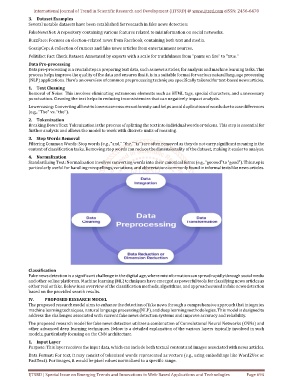Page 704 - Emerging Trends and Innovations in Web-Based Applications and Technologies
P. 704
International Journal of Trend in Scientific Research and Development (IJTSRD) @ www.ijtsrd.com eISSN: 2456-6470
3. Dataset Examples
Several notable datasets have been established for research in fake news detection:
FakeNewsNet: A repository containing various features related to misinformation on social networks.
BuzzFace: Focuses on election-related news from Facebook, containing both text and media.
GossipCop: A collection of rumors and fake news articles from entertainment sources.
Politifact Fact Check Dataset: Annotated by experts with a scale for truthfulness from "pants on fire" to "true."
Data Pre-processing
Data pre-processing is a crucial step in preparing text data, such as news articles, for analysis and machine learning tasks. This
process helps improve the quality of the data and ensures that it is in a suitable format for various natural language processing
(NLP) applications. Here’s an overview of common preprocessing techniques specifically tailored for text-based news articles.
1. Text Cleaning
Removal of Noise: This involves eliminating extraneous elements such as HTML tags, special characters, and unnecessary
punctuation. Cleaning the text helps in reducing inconsistencies that can negatively impact analysis.
Lowercasing: Converting all text to lowercase ensures uniformity and helps avoid duplication of words due to case differences
(e.g., "The" vs. "the").
2. Tokenization
Breaking Down Text: Tokenization is the process of splitting the text into individual words or tokens. This step is essential for
further analysis and allows the model to work with discrete units of meaning.
3. Stop Words Removal
Filtering Common Words: Stop words (e.g., "and," "the," "is") are often removed as they do not carry significant meaning in the
context of classification tasks. Removing stop words can reduce the dimensionality of the dataset, making it easier to analyze.
4. Normalization
Standardizing Text: Normalization involves converting words into their canonical forms (e.g., "gooood" to "good"). This step is
particularly useful for handling misspellings, variations, and abbreviations commonly found in informal texts like news articles.
Classification
Fake news detection is a significant challenge in the digital age, where misinformation can spread rapidly through social media
and other online platforms. Machine learning (ML) techniques have emerged as powerful tools for classifying news articles as
either real or fake. Below is an overview of the classification methods, algorithms, and approaches used in fake news detection
based on the provided search results.
IV. PROPOSED RESEARCH MODEL
The proposed research model aims to enhance the detection of fake news through a comprehensive approach that integrates
machine learning techniques, natural language processing (NLP), and deep learning methodologies. This model is designed to
address the challenges associated with current fake news detection systems and improve accuracy and reliability.
The proposed research model for fake news detection utilizes a combination of Convolutional Neural Networks (CNNs) and
other advanced deep learning techniques. Below is a detailed explanation of the various layers typically involved in such
models, particularly focusing on the CNN architecture.
1. Input Layer
Purpose: This layer receives the input data, which can include both textual content and images associated with news articles.
Data Format: For text, it may consist of tokenized words represented as vectors (e.g., using embeddings like Word2Vec or
FastText). For images, it would be pixel values normalized to a specific range.
IJTSRD | Special Issue on Emerging Trends and Innovations in Web-Based Applications and Technologies Page 694

